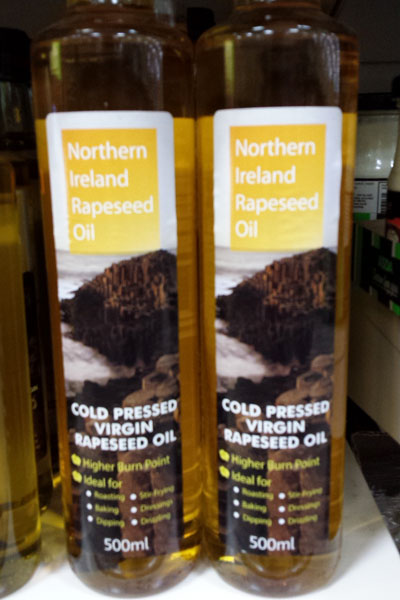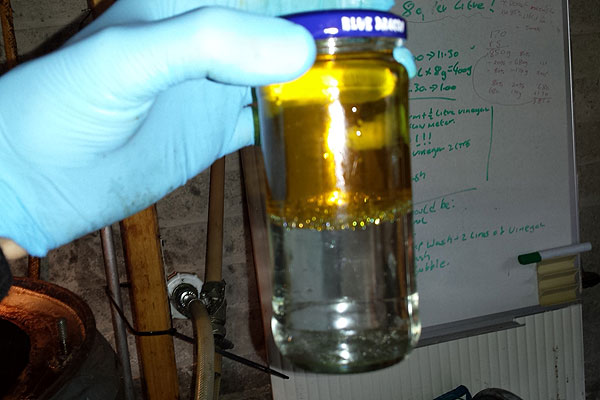Roy Murdock, from Northern Ireland, has been brewing Biodiesel for a while and as part of our call to “Show Us Your Brew!” sent in these great pictures with a neat story behind them.
We’ll start off with the first picture.

Roy gets some of his oil that uses Rapeseed Oil (similar to Canola Oil) in their cooking. Now, getting oil is cool, but there’s a “locally sustainable story” that goes along with it that’s even cooler. Turns out the oil is grown, harvested, pressed, and bottled right in Northern Ireland. Then, it’s used in local restaurants to cook locally made food. Then, the waste oil is given to Roy who filters it and reacts it into Biodiesel that is then used as fuel to power his diesel vehicles in Northern Ireland as well! Talk about from cradle to grave all in one place!
We think this story on “locally sustainability” with this oil is just flat out awesome!
Ok, on to his next picture….
When we make Biodiesel using Sodium Hydroxide or Potassium Hydroxide, one of the by-products is soap. While soap is great to wash with diesel engines and fuel filters don’t like it so we routinely remove the soap from Biodiesel by washing it with water.
Periodically through the washing process we’ll pull samples to see if we’ve removed all of the soap. One of the most common test methods for checking soap levels during washing is known as the Shake-Em Up Biodiesel Soap Test.
Roy uses this method with great success and his picture below shows a successful pass on his Biodiesel; meaning it’s done being washed and it’s now ready to be dried….

We loved seeing this picture because if you look closely behind the picture of his Bidiesel you’ll see a white board with lots of Biodiesel calculations on it. Awesome!
Ok, now for the picture we liked the best!
When Biodiesel has been washed and is wet, it tends to look like orange juice. Once all of the soap has been removed, it’s time to get all the water out of it. This can be accomplished in several ways, but typically home brewers either bubble or heat, circulate, and spray their Biodiesel to dry it out.
One of the oldest tests Biodieselers use to see if their Biodiesel is dry is to hold a sample of the fuel up with something behind it to see if it’s “clear and bright”. In otherwords, if you can see something behind it with great clarity we assume the fuel is now free of soap and also fairly dry. Here’s where Roy’s picture comes in….
He performs this test regularly but the object he looks at behind his Biodiesel is awesome!

It’s chickens! In fact, Roy say’s that if he can see 3 chickens behind his Biodiesel clearly he believes it to be fairly dry & ready to use. We call it The Three Chicken Biodiesel Dryness Test.
So, the next time you’re brewing, be sure to perform these two tests and for greater accuracy, be sure to have some chickens handy!
If you’d like to see more from Roy, be sure & stop by the Ireland section at the Biodiesel Discussion Forum. He’s a regular there & goes by Trigger.
Stop on by! You can click this link to go right to the Ireland section
http://biodiesel.infopop.cc/eve/forums/a/frm/f/5367078823
Huge thanks to Roy for sending these pictures in!
Happy Brewing!!!
-Graydon
Hi Just wanted to say that although being able to read print (like a magazine)through a sample of your biodiesel may a good indication that its dry just beware because a dry looking sample like this one above could still contain up to 1500 ppm of water,that’s 3 times the astm standard!
If your serious about quality your better using a more scientific test like a ‘sandy brae water test’ (the type Graydon sells on his site)or use a ‘Carbide manometer’ which was invented here in Ireland by biodiesel inventor & extraordinaire John O’Neill.
It beats asking chickens…chickens know nothing about bio they just stare and give the occasional cluck as if to say “you sure you know what your doing?”
Regards- Trigger(Roy)
Roy, Thanks again so much for the pictures! The chickens dryness test was the highlight of all of them! Great tips too!
-Graydon